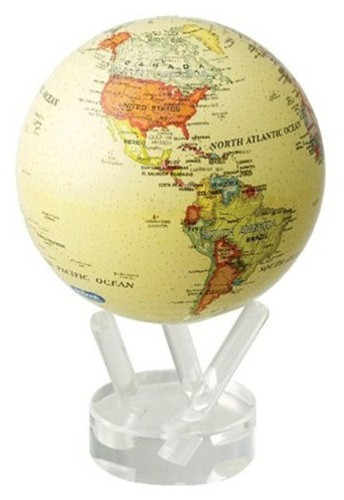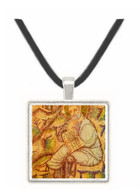- Home
- Art, Collectibles, Home & Decor
- Globes, Instruments, Models & Decor
- MOVA-MUSEUM Antique Beige Self Powered Solar Globe
Product Description
The MOVA-MUSEUM globe rotates silently and is inspired by the earth itself. It requires no power cords or batteries. . .only the natural light of your home or office. Our three- fingered acrylic base is included with every MOVA-MUSEUM globe. We also offer additional base models, or you can place the MOVA-MUSEUM globe on the base of your choice.
- Antique Beige/Yellow color.
- Includes acrylic stand.
- 4.5" wide.
- 7 1/2" high.
How MOVA-MUSEUM Globe Works
The MOVA-MUSEUM globe rotates peacefully and silently using only the energy of room light and the force of the earth’s magnetic field. The MOVA-MUSEUM globe is an inner globe that rotates and is contained within an outer shell made of very clear acrylic that does not rotate. The thin space between the inner globe and outer shell is filled with a safe, perfectly clear fluid that buoyantly supports the inner globe completely out of contact with the outer shell. This inner globe, floating and turning in a virtually friction-free environment and energized by light, is analogous to the earth itself. The MOVA-MUSEUM globe is being brought to market at a time when people everywhere will understand and appreciate this analogy. The optical properties of the outer sell and fluid are carefully chosen so that the graphic features on the surface of the inner globe are magnified and appear to be on the outer surface of the outer shell. This means that the outer shell actually appears to move. The MOVA-MUSEUM globe can rest on an attractive three fingered stand that is provided, or on just about any other kind of stand that can be chosen to complement it’s graphic design. The MOVA-MUSEUM globe appears to rotate in spite of resting on the stand, in quiet defiance of commonly held ideas about the laws of friction. A carefully designed, and highly efficient drive mechanism within the inner globe drives the rotation even in room light. Energy for the drive is provided by very advanced solar cells within the inner globe, illuminated by light passing through the graphic on the globe. The drive includes a magnetic element that reacts with the earth’ s magnetic field, much as a common compass does, to provide torque to drive the globe. All of these elements of the MOVA-MUSEUM globe cooperate to create a beautiful, magical object that provides a meditative point of focus to any room.
Technology Brief on the MOVA-MUSEUM Globe
You know that its an optical illusion, but how do we create that illusion? And, how does the globe turn without batteries or wires, in a completely sealed and fluid-filled environment?
The "technology brief" below will explain in part some of the new technologies developed to get the MOVA-MUSEUM globe to turn when you turn on the light switch.
•Low-light solar cell technology -- The solar cells are placed inside the globe and behind the globe graphics. Most of the ambient light is blocked by the graphics. To produce useful electrical energy from such a low light, these solar cells have to be specially designed and tested.
•Use of the earth’s magnetic field to produce countertourque – For the MOVA-MUSEUM globes’ motor to get the globe started turning, and to keep it turning, the motor needs a source of countertorque. The MOVA-MUSEUM globe uses the earth’s magnetic field to push against. Think of the needle in a compass. The motor is, in effect, pushing against the needle, which is held stationary by the earth’s magnetic field.
•Ultra low friction motor design -- at least an order of magnitude lower friction than current motors used for consumer applications. This makes it possible for the motor to turn, in complete silence, with extremely low power in the micro watt range (a micro watt is one millionth of a watt).
•Micro volume fluid levitation technology -- making it possible for the inner globe to levitate, start up and turn continuously, without touching the outer shell, in a very thin layer of fluid between the outer shell and the inner globe.
 Loading... Please wait...
Loading... Please wait...









